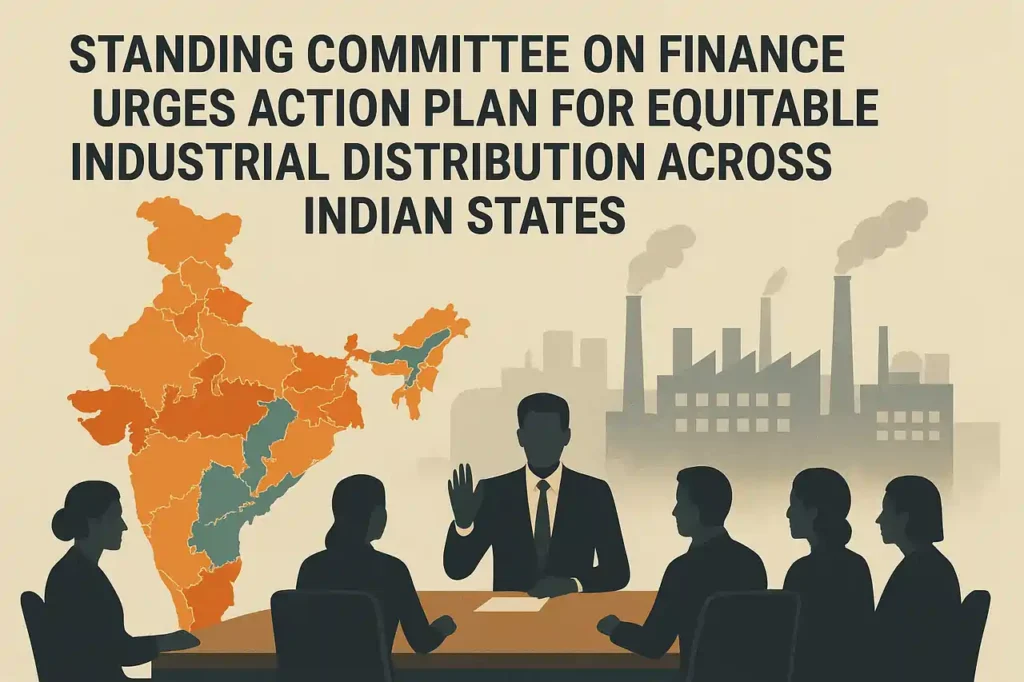New Delhi: In a pivotal move to address regional economic disparities, the Standing Committee on Finance has called on the Central Government to devise an action plan to ensure the even distribution of industries across all Indian states. The recommendation, outlined in a report submitted to the Lok Sabha, aims to foster “more balanced and equitable economic development” nationwide, addressing long-standing imbalances in industrial growth that have favored certain regions over others.
This call for action comes amid heightened political tensions, with the Congress party accusing the Central Government of bias against opposition-ruled states, alleging that new investments are being redirected away from these regions. The committee’s report, chaired by Bharatiya Janata Party MP from Odisha, Bhartruhari Mahtab, also highlights stagnation in the government’s disinvestment plans and the need to boost India’s investment rate to achieve ambitious growth targets.

Stark Disparities in Industrial Development
The Economic Survey 2024-25, referenced in the committee’s report, underscored significant disparities in industrial development across India. While states like Gujarat, Uttarakhand, and Himachal Pradesh have effectively leveraged industrial opportunities, northern and eastern states lag far behind, exhibiting low levels of industrialization. The manufacturing sector, in particular, reveals a stark contrast: Tamil Nadu leads with a high concentration of factories, whereas Bihar struggles with a minimal industrial presence.
The Standing Committee emphasized that, although industry is a state subject, the Central Government’s initiatives are crucial for driving nationwide industrial progress. “The Committee recommends the Government to consider an action plan for the even distribution of industries across all States for more balanced and equitable economic development,” the report stated.
Root Causes of Uneven Industrial Growth
Several factors contribute to the uneven industrial landscape, as detailed in the report and the Economic Survey 2025:
- Historical Factors: Regional imbalances trace back to the British colonial era, when development was concentrated in areas like West Bengal and Maharashtra, leaving other regions at a disadvantage. This historical legacy continues to shape industrial disparities today.
- Geographical Challenges: States in the Himalayan belt and the North-Eastern Region face difficult terrain, posing logistical barriers to industrial growth. These areas struggle to attract investment due to their challenging topography.
- Inadequate Infrastructure: Variations in power supply, transportation networks, and land availability hinder industrial development in regions like the North-Eastern states and Bihar. Reliable infrastructure, including electricity, roads, railways, and ports, is critical for industrial success but remains unevenly distributed.
- Policy and Planning Disparities: Initiatives like the Green Revolution primarily benefited states such as Punjab and Haryana, boosting their agricultural economies but leaving others behind in industrial diversification. This has exacerbated regional imbalances over time.
The Economic Survey 2025 advocates for balanced industrial policies, deregulation, and infrastructure improvements to promote sustainable growth. It emphasizes the need for robust Centre-state cooperation, with the Central Government supporting lagging regions through investments in infrastructure, education, skill development, and access to credit.
Political Accusations of Bias
The committee’s recommendations come at a time of political friction. On August 14, 2025, Congress general secretary in-charge of communications, Jairam Ramesh, took to the social media platform X to accuse the Central Government of approving company investments only if they are moved out of opposition-ruled states. “The PM speaks of competition among states that will make India strong,” Mr. Ramesh remarked. “But if the umpire is so blatantly biased, the competition becomes a farce.”
These allegations highlight concerns about fairness in economic policy and underscore the urgency of the committee’s call for equitable industrial distribution. By addressing these disparities, the government could counter claims of favoritism and strengthen federal cooperation.
Stalled Disinvestment and Public Sector Reforms
Beyond industrial distribution, the Standing Committee’s report critiques the lack of progress in the government’s disinvestment plans. The Public Sector Enterprise (PSE) Policy, introduced to promote fiscal prudence and efficient resource allocation, targets loss-making public sector companies in non-strategic sectors for privatization or closure. However, the report notes that no proposals for disinvestment of non-strategic Central Public Sector Enterprises (CPSEs) have been approved since the guidelines were issued in December 2021.
The committee urged the government to accelerate the implementation of the PSE Policy by streamlining the process of identifying and approving non-strategic, loss-making CPSEs for disinvestment or closure. It also highlighted the Central Government’s role in incentivizing states to reform their state-level Public Sector Undertakings (PSUs) through incentive packages from central funds. The report recommends reviewing these packages to make them more attractive, encouraging greater state participation in the reform process.
Boosting Investment for Economic Growth
The report also addresses India’s broader economic challenges, particularly the need to increase the national investment rate. Currently at approximately 31% of GDP, the investment rate must rise to around 35% to sustain an annual growth rate of 8% for at least a decade—a target the committee describes as ambitious.
Achieving this goal will be challenging in the current global economic environment. The committee recommends tailored fiscal reforms for highly indebted states to improve their fiscal health while preserving their capacity to invest in critical infrastructure and social development. These reforms are essential for creating an environment conducive to higher investments, which in turn will drive economic expansion and job creation.
A Blueprint for Inclusive Development
The Standing Committee’s report, supported by insights from the Economic Survey 2025, provides a comprehensive blueprint for addressing India’s industrial disparities. By tackling historical, geographical, infrastructural, and policy-related challenges, the government can pave the way for a more inclusive economic landscape. The emphasis on Centre-state collaboration, accelerated disinvestment, and increased investments aligns with the goal of ensuring no state is left behind in India’s growth journey.
Looking Ahead
As India strives for equitable economic development, the Standing Committee on Finance’s recommendations serve as a clarion call for action. By formulating an action plan to evenly distribute industries, the Central Government can address long-standing disparities and counter accusations of bias. The success of these efforts will depend on effective collaboration between the Centre and states, as well as the timely implementation of reforms in disinvestment, infrastructure, and fiscal policy.
With the Economic Survey 2025 and the Standing Committee’s report setting the stage, stakeholders across the political and economic spectrum await concrete steps to translate these recommendations into reality. The goal is clear: a stronger, more inclusive India where every state contributes to and benefits from the nation’s economic progress.

